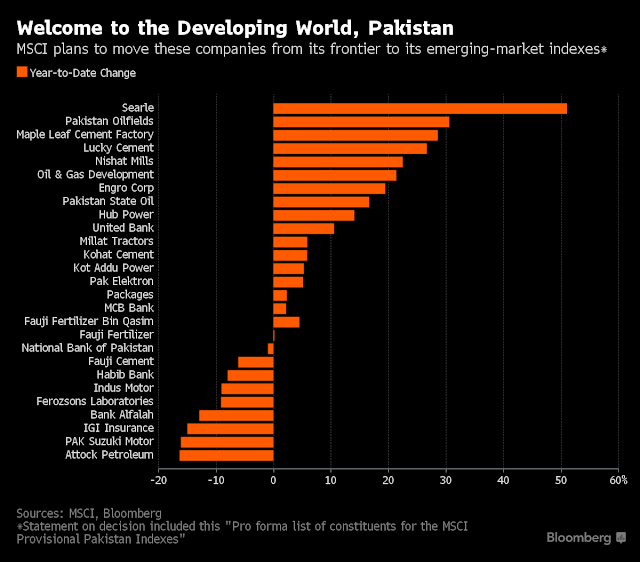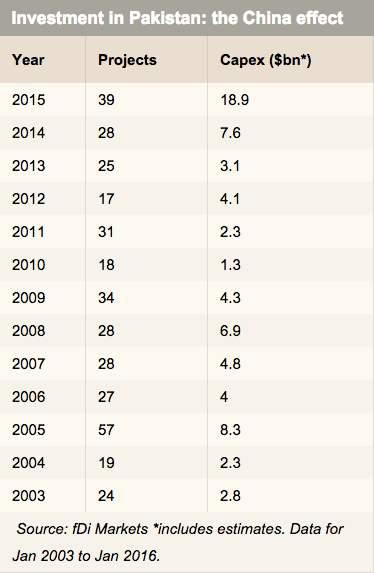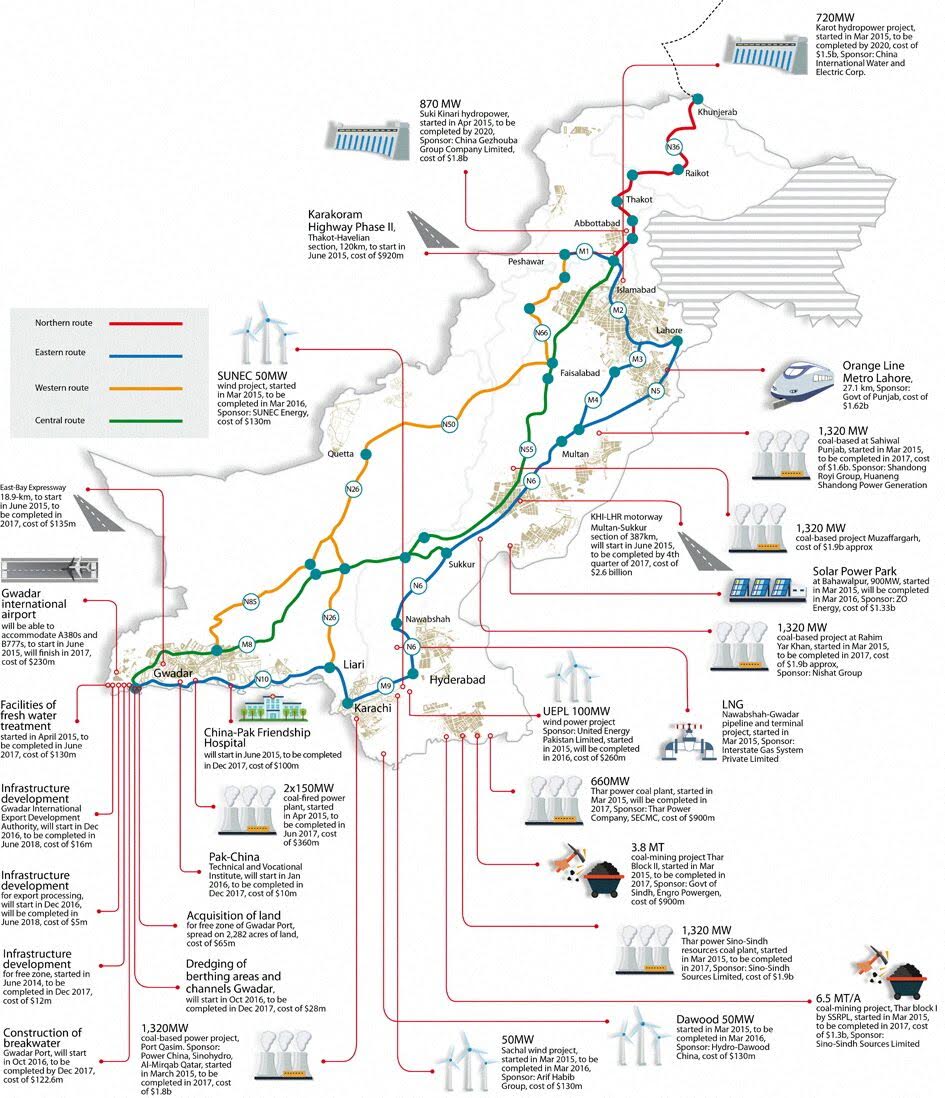MSCI Adds Pakistan Shares to Emerging Markets Index
MSCI Pakistan Index will be reclassified to Emerging Markets status, coinciding with the May 2017 Semi-Annual Index Review, according to an MSCI press release on June 14, 2016.
Emerging Market Upgrade:
Pakistan's Karachi Stock Exchange KSE100 Index has rallied 14% in 2016, making it Asia's best performing market so far this year in anticipation of the MSCI announcement.
The upgrade could attract additional $475 million of inflows by the middle of next year as investors rush to buy Pakistani shares, according to analysts quoted by Bloomberg News.
Pakistan was classified as Emerging Market in 1994, a status it retained during the Musharraf years. It was downgraded to frontier status in December 2008, four months after the former president was forced out by PPP and PMLN politicians.
Loss of investor confidence after President Musharraf's departure triggered a major bear market that wiped out nearly $37 billion of market capitalization at the Karachi Stock Exchange. It led to the imposition of a floor on share prices that caused near total paralysis of market activity for more than three months, according to Bloomberg News.
Pakistan is seeing soaring foreign direct investment (FDI) with improving security and the start of several major energy and infrastructure projects as part of China-Pakistan Economic Corridor (CPEC), according to the UK's Financial Times business newspaper.
A New High in FDI:
The year 2015 was a bumper year for foreign investment pouring into Pakistan, says the Financial Times. The country saw 39 greenfield investments adding up to an estimated $18.9 billion last year, according to fDi Markets, an FT data service. This is a big jump from 28 projects for $7.6 billion started in 2014, and marks a new high for greenfield capital investment into the country since fDi began collecting data in 2003.
The number of projects in 2015 is the largest since Pakistan attracted 57 greenfield projects back in 2005 on President Musharraf's watch. China is now the top source country for investment into the country, surpassing the second-ranked United Arab Emirates, primarily due to its investments in power.
Major CPEC Projects:
China's Shanghai Electric, a power generation and electrical equipment manufacturing company, announced plans last year to establish a 1,320 megawatt coal-based power project in Thar desert using domestic coal, scheduled to launch in 2017 or 2018. Traditional energy and power projects made up two-thirds of last year’s total greenfield investment into Pakistan at $12.9 billion with alternative energy bringing in a further $1.8 billion.
Among the more notable projects, UAE-based Metal Investment Holding Corporation announced plans to partner with Power China E & M International to invest $5 billion to build three coal-fired plants at Karachi’s Port Qasim. In addition, the transportation sector is also showing promise, with 12 projects totaling $3 billion being announced or initiated last year.
Special Economic Zones:
Beyond the initial phase of power and road projects, there are plans to establish special economic zones in the Corridor where Chinese companies will locate factories. Extensive manufacturing collaboration between the two neighbors will include a wide range of products from cheap toys and textiles to consumer electronics and supersonic fighter planes.
The basic idea of an industrial corridor is to develop a sound industrial base, served by competitive infrastructure as a prerequisite for attracting investments into export oriented industries and manufacturing. Such industries have helped a succession of countries like Indonesia, Japan, Hong Kong, Malaysia, South Korea, Taiwan, China and now even Vietnam rise from low-cost manufacturing base to more advanced, high-end exports. As a country's labour gets too expensive to be used to produce low-value products, some poorer country takes over and starts the climb to prosperity.
Once completed, the Pak-China industrial corridor with a sound industrial base and competitive infrastructure combined with low labor costs is expected to draw growing FDI from manufacturers in many other countries looking for a low-cost location to build products for exports to rich OECD nations.
Key Challenges:
While the commitment is there on both sides to make the corridor a reality, there are many challenges that need to be overcome. The key ones are maintaining security and political stability, ensuring transparency, good governance and quality of execution. These challenges are not unsurmountable but overcoming them does require serious effort on the part of both sides but particularly on the Pakistani side. Let's hope Pakistani leaders are up to these challenges.
Summary:
Pak-China economic corridor is a very ambitious effort by the two countries that will lead to greater investment and rapid industrialization of Pakistan. Successful implementation of it will be a game-changer for the people of Pakistan in terms of new economic opportunities leading to higher incomes and significant improvements in the living standards for ordinary Pakistanis. It will be in the best interest of all of them to set their differences aside and work for its successful implementation.
Related Links:
Haq's Musings
Chinese to Set New FDI Record For Pakistan
Pak Army Completes Half of CPEC Western Route
Chabahar and Gwadar Ports
Pakistan Launches $8.2 Billion Railway Upgrade
Pak-China Defense Industry Collaboration Irks West
President Musharraf Accelerated Human and Financial Capital Growth in Pakistan
China's Investment and Trade in South Asia
China Signs Power Plant Deals with Pakistan
Soaring Imports from China Worry India
China's Checkbook Diplomacy
Emerging Market Upgrade:
Pakistan's Karachi Stock Exchange KSE100 Index has rallied 14% in 2016, making it Asia's best performing market so far this year in anticipation of the MSCI announcement.
 |
| Source: Bloomberg |
The upgrade could attract additional $475 million of inflows by the middle of next year as investors rush to buy Pakistani shares, according to analysts quoted by Bloomberg News.
Pakistan was classified as Emerging Market in 1994, a status it retained during the Musharraf years. It was downgraded to frontier status in December 2008, four months after the former president was forced out by PPP and PMLN politicians.
Loss of investor confidence after President Musharraf's departure triggered a major bear market that wiped out nearly $37 billion of market capitalization at the Karachi Stock Exchange. It led to the imposition of a floor on share prices that caused near total paralysis of market activity for more than three months, according to Bloomberg News.
Pakistan is seeing soaring foreign direct investment (FDI) with improving security and the start of several major energy and infrastructure projects as part of China-Pakistan Economic Corridor (CPEC), according to the UK's Financial Times business newspaper.
A New High in FDI:
The year 2015 was a bumper year for foreign investment pouring into Pakistan, says the Financial Times. The country saw 39 greenfield investments adding up to an estimated $18.9 billion last year, according to fDi Markets, an FT data service. This is a big jump from 28 projects for $7.6 billion started in 2014, and marks a new high for greenfield capital investment into the country since fDi began collecting data in 2003.
 |
| Pakistan FDI Source: FT.com |
The number of projects in 2015 is the largest since Pakistan attracted 57 greenfield projects back in 2005 on President Musharraf's watch. China is now the top source country for investment into the country, surpassing the second-ranked United Arab Emirates, primarily due to its investments in power.
 |
| Top 10 Destinations of Chinese FDI 2012-14. Source: UNESCAP |
Major CPEC Projects:
China's Shanghai Electric, a power generation and electrical equipment manufacturing company, announced plans last year to establish a 1,320 megawatt coal-based power project in Thar desert using domestic coal, scheduled to launch in 2017 or 2018. Traditional energy and power projects made up two-thirds of last year’s total greenfield investment into Pakistan at $12.9 billion with alternative energy bringing in a further $1.8 billion.
 |
| CPEC Projects |
Among the more notable projects, UAE-based Metal Investment Holding Corporation announced plans to partner with Power China E & M International to invest $5 billion to build three coal-fired plants at Karachi’s Port Qasim. In addition, the transportation sector is also showing promise, with 12 projects totaling $3 billion being announced or initiated last year.
Special Economic Zones:
Beyond the initial phase of power and road projects, there are plans to establish special economic zones in the Corridor where Chinese companies will locate factories. Extensive manufacturing collaboration between the two neighbors will include a wide range of products from cheap toys and textiles to consumer electronics and supersonic fighter planes.
The basic idea of an industrial corridor is to develop a sound industrial base, served by competitive infrastructure as a prerequisite for attracting investments into export oriented industries and manufacturing. Such industries have helped a succession of countries like Indonesia, Japan, Hong Kong, Malaysia, South Korea, Taiwan, China and now even Vietnam rise from low-cost manufacturing base to more advanced, high-end exports. As a country's labour gets too expensive to be used to produce low-value products, some poorer country takes over and starts the climb to prosperity.
Once completed, the Pak-China industrial corridor with a sound industrial base and competitive infrastructure combined with low labor costs is expected to draw growing FDI from manufacturers in many other countries looking for a low-cost location to build products for exports to rich OECD nations.
Key Challenges:
While the commitment is there on both sides to make the corridor a reality, there are many challenges that need to be overcome. The key ones are maintaining security and political stability, ensuring transparency, good governance and quality of execution. These challenges are not unsurmountable but overcoming them does require serious effort on the part of both sides but particularly on the Pakistani side. Let's hope Pakistani leaders are up to these challenges.
Summary:
Pak-China economic corridor is a very ambitious effort by the two countries that will lead to greater investment and rapid industrialization of Pakistan. Successful implementation of it will be a game-changer for the people of Pakistan in terms of new economic opportunities leading to higher incomes and significant improvements in the living standards for ordinary Pakistanis. It will be in the best interest of all of them to set their differences aside and work for its successful implementation.
Related Links:
Haq's Musings
Chinese to Set New FDI Record For Pakistan
Pak Army Completes Half of CPEC Western Route
Chabahar and Gwadar Ports
Pakistan Launches $8.2 Billion Railway Upgrade
Pak-China Defense Industry Collaboration Irks West
President Musharraf Accelerated Human and Financial Capital Growth in Pakistan
China's Investment and Trade in South Asia
China Signs Power Plant Deals with Pakistan
Soaring Imports from China Worry India
China's Checkbook Diplomacy




Comments
http://www.business-standard.com/article/reuters/pakistan-shares-soar-to-all-time-high-after-msci-upgrade-116061500324_1.html
Pakistan's benchmark index jumped as much as 3% in early trade on Wednesday, climbing to a record high after the country's stock market was reclassified overnight and included in the MSCI's emerging market index category.
By 10.55 a.m. local time (0555 GMT), the benchmark 100-share index of the Pakistan Stock Exchange was up 865.68 points, or 2.3%, at 38,383.43 points.
The index recorded its biggest single-day gain since March 31, 2015, and is one of Asia's best performers this year.
Pakistani brokerages upgraded their outlook on the market and said the main index was now likely to rise above 40,000 by the end of the year.
"Pakistan's market multiple is lower than the emerging market multiple so there will most likely be a re-rating of the Pakistan market in the short term," said Saad Hashmey, chief economist and director of research for Topline Securities.
"It might not be as high as the emerging market but there will be plenty of upside," he added.
The stock exchange was dropped from the MSCI Emerging Markets Index when it imposed a floor on the market during the financial crisis in 2008, effectively trapping local and foreign investors for several months.
Over the past few years officials have been enacting a host of market reforms to regain the trust of investors, including demutualising Pakistan's bourses to weaken the influence of stockbrokers and deepen the investor base.
Intermarket Securities, a local brokerage, said the move by MSCI had prompted it to upgrade its end-of-year target for the benchmark index to 41,000 points.
"The jovial mood following this re-rating event is expected to reflect in market performance today," Intermarket said in an early morning research note.
Traders said large-cap stocks expected to be included in the MSCI Emerging Market index were trading higher. Habib Bank was up 3.83% at 191.30 rupees, while Oil and Gas Development Company jumped 2.95% to 146.60 rupees.
Research firms estimate the MSCI upgrade will result in about $400 million in inflows into Pakistan's stock market by passive tracker funds alone.
Pakistan stocks plunged more than 2 percent and recorded their biggest percentage loss in more than five months as Britain's exit from the European Union rattled global markets.
The benchmark 100-share index of the Pakistan Stock Exchange closed down 2.22 percent, or 848.01 points, at 37,389.88, after recovering from an intraday low of 36,826.
"Markets fell as an impact of Britain's exit from EU, Asian markets fell as well as commodity prices. Oil prices are also down by five percent," said Fawad Khan, head of research, KASB Securities Private Limited.
Index heavyweights that led the losses include Oil and Gas Development Co Ltd, which slipped 4.18 percent, while Pakistan Petroleum Limited declined 4.34 percent and Pakistan Oil fields Ltd fell 3.93 percent.
Yen has appreciated as a result of Britain's exit, hurting auto sector stocks.
Honda Atlas Cars (Pakistan) Ltd lost 5 percent and Pak Suzuki Motor Co Ltd declined 5 percent.
Pakistan's primary energy consumption increased by 5.9 percent to 78.2 million ton oil equivalent (MTOE) in 2015, compared with 73.2MTOE in 2014 depicting higher economic activities.
According to the statistical data of British Petroleum on energy use around the world, the primary energy consumption in China grew by 1.12 percent from 2014 to 2015 that has resulted in slowdown in China’s economy. India’s primary energy consumption increased by 5.1 percent during the same period which is lower than that of Pakistan. Indian GDP growth, though highest in the world remains much below the peaks it attained at the start of this decade.
The fuels consumed for producing primary energy show that in 2014, Pakistan consumed 22.8MTOE of oil that increased to 25.2MTOE in 2015. Its natural gas use also increased from 37.7MTOE in 2014 to 39.0MTOE in 2015. The consumption of coal remained the same at 4.7MTOE in both years.
According to the report, electricity consumption in Pakistan increased from 96.2 terawatt-h in 2008 110.0 terawatt-h in 2015. The increase was restricted to 99.3 terawatt-h till 2012; showing cumulative increase of 4 percent only, but in the next three years the consumption cumulatively increased by 10.7 percent of which 2.7 percent increase was in 2015 over 2014. Indian electricity consumption in comparison increased more robustly being 833.4 terawatt-h in 2008 that increased to 1,304.8 terawatt-h in 2015.
---
India produces 45.5MTOE from natural gas, 407.2MTOE from coal that is 100 times more than the primary energy that Pakistan derives from coal. Its hydro electric generation is 8.6MTOE. It derives 15.5MTOE from renewable that is 30 times more than what Pakistan obtains from renewable. The primary energy obtained by China from natural gas is 177.6MTOE, from coal it is a whopping 19,203MTOE. Its hydro electric energy amounts to 254.9MTOE, nuclear 38.6MTOE and renewable 62.7MTOE. The renewable energy extracted by China is equivalent to 60 percent of the total energy produced in Pakistan.
Bangladesh in 2008 consumed only 34.2 terawatt-h electricity that was almost 1/3rd of the power consumption in Pakistan. In 2015 the gap was reduced to 60 percent of the power consumed in Pakistan. Bangladesh is exporting much more than Pakistan despite low power use because it adds high value to its apparel. The power requirement of the garment industry is nominal when compared with spinning, weaving and processing that produce low value-added textiles exported by Pakistan. The electricity consumption in China increased to 5,810 terawatt-h in 2015 compared with 3495 terawatt-h in 2008.
Coal, wind and solar energy are the cheapest source of energy around the world. Wind and solar along with hydro electricity are the cleanest energy fuels. China fulfilled 1,920MTOE of its energy needs from coal, India 388.7MTOE, and Pakistan only 4.7MTOE. Coal use for energy production is confined only to the private sector in Pakistan. Around 3,000MW coal based power plants are expected to be commissioned by 2019 after which share of coal in the energy mix would substantially increase. Wind power consumption in China was 41MTOE in 2015, it was 9.4MTOE in India and only 0.1MTOE in Pakistan. Solar power production in 2015 was 8.9MTOE in China, 1.5MTOE in India and only 0.3MTOE in Pakistan. Pakistan is also on the course to double its hydro electric production to over 16,000MW by the end of 2021.
https://www.thenews.com.pk/print/131885-Increase-in-Pakistans-energy-consumption-depicts-higher-economic-activities
http://www.bp.com/content/dam/bp/pdf/energy-economics/statistical-review-2016/bp-statistical-review-of-world-energy-2016-full-report.pdf